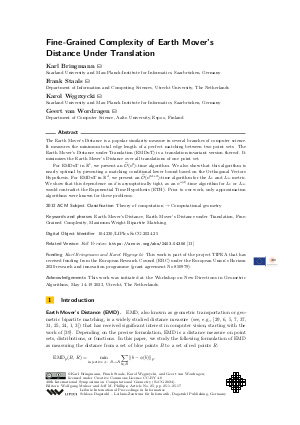LIPIcs.SoCG.2024.25.pdf
- Filesize: 0.87 MB
- 17 pages

 Creative Commons Attribution 4.0 International license
Creative Commons Attribution 4.0 International license

The Earth Mover’s Distance is a popular similarity measure in several branches of computer science. It measures the minimum total edge length of a perfect matching between two point sets. The Earth Mover’s Distance under Translation (EMDuT) is a translation-invariant version thereof. It minimizes the Earth Mover’s Distance over all translations of one point set.
For EMDuT in ℝ¹, we present an 𝒪̃(n²)-time algorithm. We also show that this algorithm is nearly optimal by presenting a matching conditional lower bound based on the Orthogonal Vectors Hypothesis. For EMDuT in ℝ^d, we present an 𝒪̃(n^{2d+2})-time algorithm for the L₁ and L_∞ metric. We show that this dependence on d is asymptotically tight, as an n^o(d)-time algorithm for L_1 or L_∞ would contradict the Exponential Time Hypothesis (ETH). Prior to our work, only approximation algorithms were known for these problems.



Feedback for Dagstuhl Publishing